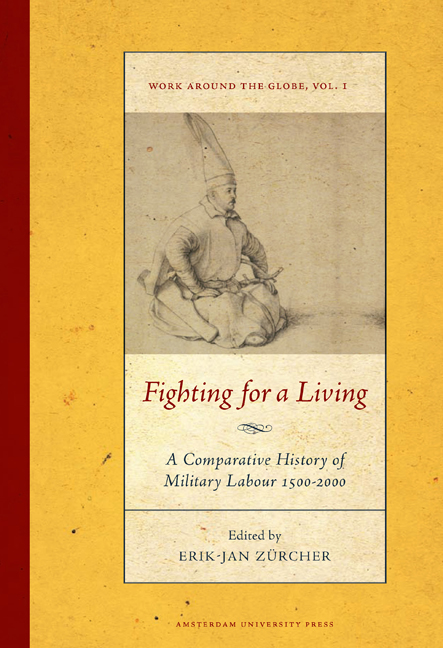Book contents
- Frontmatter
- Dedication
- Contents
- Preface
- Introduction: Understanding Changes in Military Recruitment and Employment Worldwide
- Military Labor in China, c. 1500
- From the Mamluks to the Mansabdars: A Social History of Military Service in South Asia, c. 1500 to c. 1650
- On the Ottoman Janissaries (Fourteenth-nineteenth Centuries)
- Soldiers in Western Europe, c. 1500-17901
- The Scottish Mercenary as a Migrant Labourer in Europe, 1550-1650
- Change and Continuity in Mercenary Armies: Central Europe, 1650-1750
- Peasants Fighting for a Living in Early Modern North India
- “True to Their Salt”: Mechanisms for Recruiting and Managing Military Labour in the Army of the East India Company During the Carnatic Wars in India
- “The Scum of Every County, the Refuse of Mankind”: Recruiting the British Army in the Eighteenth Century
- Mobilization of Warrior Populations in the Ottoman Context, 1750-1850
- Military Employment in Qing Dynasty China
- Military Service and the Russian Social Order, 1649-1861
- The French army, 1789-1914: Volunteers, Pressed Soldiers, and Conscripts
- The Dutch Army in Transition: From All-volunteer Force to Cadre-militia Army, 1795-1830
- The Draft and Draftees in Italy, 1861-1914
- Nation-building, War Experiences, and European Models: The Rejection of Conscription in Britain
- Mobilizing Military Labor in the Age of Total War: Ottoman Conscription Before and During the Great War
- Soldiering as Work: The All-volunteer Force in the United States
- Private Contractors in War From the 1990s to the Present: A Review Essay
- Collective Bibliography
- Notes on Contributors
The Dutch Army in Transition: From All-volunteer Force to Cadre-militia Army, 1795-1830
Published online by Cambridge University Press: 12 December 2020
- Frontmatter
- Dedication
- Contents
- Preface
- Introduction: Understanding Changes in Military Recruitment and Employment Worldwide
- Military Labor in China, c. 1500
- From the Mamluks to the Mansabdars: A Social History of Military Service in South Asia, c. 1500 to c. 1650
- On the Ottoman Janissaries (Fourteenth-nineteenth Centuries)
- Soldiers in Western Europe, c. 1500-17901
- The Scottish Mercenary as a Migrant Labourer in Europe, 1550-1650
- Change and Continuity in Mercenary Armies: Central Europe, 1650-1750
- Peasants Fighting for a Living in Early Modern North India
- “True to Their Salt”: Mechanisms for Recruiting and Managing Military Labour in the Army of the East India Company During the Carnatic Wars in India
- “The Scum of Every County, the Refuse of Mankind”: Recruiting the British Army in the Eighteenth Century
- Mobilization of Warrior Populations in the Ottoman Context, 1750-1850
- Military Employment in Qing Dynasty China
- Military Service and the Russian Social Order, 1649-1861
- The French army, 1789-1914: Volunteers, Pressed Soldiers, and Conscripts
- The Dutch Army in Transition: From All-volunteer Force to Cadre-militia Army, 1795-1830
- The Draft and Draftees in Italy, 1861-1914
- Nation-building, War Experiences, and European Models: The Rejection of Conscription in Britain
- Mobilizing Military Labor in the Age of Total War: Ottoman Conscription Before and During the Great War
- Soldiering as Work: The All-volunteer Force in the United States
- Private Contractors in War From the 1990s to the Present: A Review Essay
- Collective Bibliography
- Notes on Contributors
Summary
In 1748, the last year of the War of the Austrian Succession (1740-1748), the army of the United Provinces had a strength on paper of 126,000 men, the actual strength being approximately 90,000. This was an impressive number and by and large the equivalent of the complement during the War of the Spanish Succession (1701-1714). Over the peacetime years after 1748 numbers declined to just over 40,000. This still constituted a considerable force. As a rule of a thumb eighteenth-century political-military leadership considered an army equivalent to 1 or 1.5 per cent of the population acceptable to secure the safety of the state in time of peace. Given a population of 1.9 million inhabitants around 1750 the United Provinces mobilized an army of 2.1 per cent of the population. However, the actual strength of the army of the Batavian Republic (1795-1806) and the Kingdom of Holland (1806-1810) sank to numbers ranging from only 22,000 men to 37,000. This is remarkable taking into account that the second half of the eighteenth century saw a slow growth of the population, reaching a total of just over 2 million inhabitants in 1795 and considering that during those years Holland was fully engaged in the war effort of revolutionary and Napoleonic France. These decreasing numbers reflect the persisting financial exhaustion of the United Provinces after the War of the Austrian Succession. From 1810 onwards things were hardly any better. During the period of the annexation of Holland to the French Empire (1810-1813) in all an estimated 35,000 Dutch military served under Bonaparte's colours.
The shift came after the restoration of Dutch independence in November 1813. As from January 1814 the peacetime establishment of the army of the newly founded kingdom of William I called for a total of 52,000 men. On this basis, after a five-year period a wartime strength of 145,000 would have been within grasp. For the first time since 1748 the Dutch army on a war footing as well as on a peace footing would have exceeded the figures of the days of the old republic, when the country was considered a power of the first rank in Europe.
- Type
- Chapter
- Information
- Fighting for a LivingA Comparative Study of Military Labour 1500–2000, pp. 447 - 478Publisher: Amsterdam University PressPrint publication year: 2013
- 2
- Cited by

